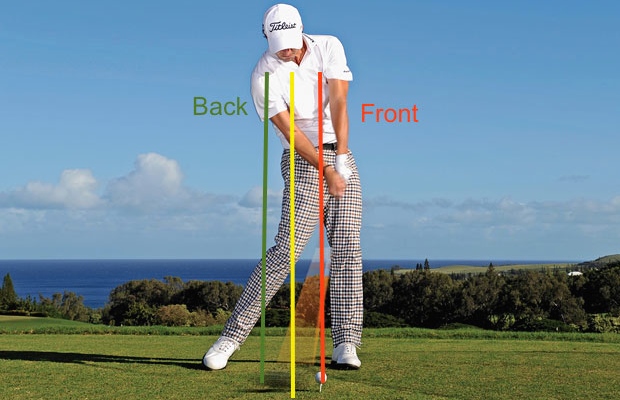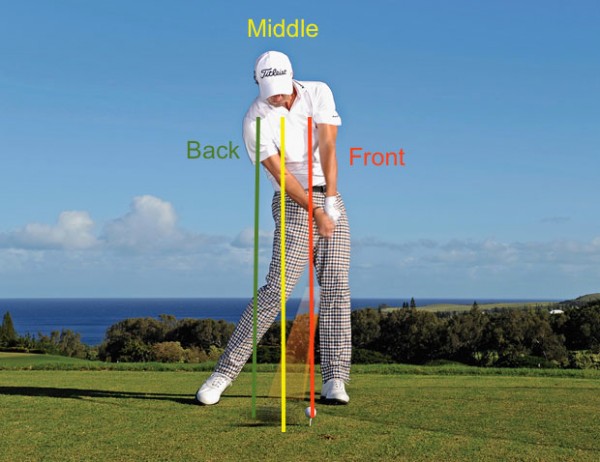Instruction
Finding the bottom of your swing arc with weight shift

You’ve heard it before and you’ll hear it again. One of the most popular tips in golf is for players to “keep their head still.” This is a broad term that’s better understood by looking at what I call the three posts in the golf swing.
These “posts” represent where your head and sternum should be at the top of your swing. As you can see in the photo above, I have drawn the the three posts that a player can rotate around during the backswing. What post you are — front, middle or back — will determine if your head remains still or moves slightly away from the ball on your backswing. There is no single post that is right for every player, but each player will fall into one of the three posts. The best way to find what post you are is to test all three and see which one allows you to make your own best personal swing.
So many players think that the head must stay centered on the middle post to produce the best results and this is not at all true. Again, it depends on the player. The one thing that we do know is that on the downswing all great players move to their front post before impact, or at impact and through impact to the finish.
Here we can see Adam Scott at impact and how his weight and sternum have gotten over his front post. His head is in motion and following his turn. At the finish, he will be rotated fully around his front post.
A test that will help you choose which post is best for you
First, swing to the top and try to keep your head on the back post. That will mean that your head will not go back behind your back leg. If it does, you have moved well to far back. This will cause a mad race to catch up on the downswing and will have you trying to get over your front post at impact. If you are behind that front post at impact, the result will be a thin shot or a fat shot.
Next try the middle post. Swing to the top and keep your lower body quiet, keeping your head and sternum where they were at address. If you move behind the middle post, you will again have a tough time getting back to the front post.
Trying the front post will feel almost like “Stack and Tilt.” As you move to the top, your head will move forward slightly and it will feel like your weight has stayed on your front foot. You will remain there, then rotate around the same front post that you felt at the top of your backswing.
One of the three of these posts will work and feel the best to you, so fool around with all three on the range to see which one clicks. Once you find it, make sure that you don’t go back past that post on your backswing, and remember to always rotate around your front post on your downswing. This will allow your swing arc to bottom out in front of the ball, resulting in the forward swing bottom that we all desire.
- LIKE16
- LEGIT1
- WOW0
- LOL0
- IDHT0
- FLOP2
- OB0
- SHANK2
Instruction
Clement: Laid-off or perfect fade? Across-the-line or perfect draw?

Some call the image on the left laid off, but if you are hitting a fade, this could be a perfect backswing for it! Same for across the line for a draw! Stop racking your brain with perceived mistakes and simply match backswing to shot shape!
- LIKE0
- LEGIT0
- WOW0
- LOL0
- IDHT0
- FLOP0
- OB0
- SHANK0
Instruction
The Wedge Guy: The easiest-to-learn golf basic

My golf learning began with this simple fact – if you don’t have a fundamentally sound hold on the golf club, it is practically impossible for your body to execute a fundamentally sound golf swing. I’m still a big believer that the golf swing is much easier to execute if you begin with the proper hold on the club.
As you might imagine, I come into contact with hundreds of golfers of all skill levels. And it is very rare to see a good player with a bad hold on the golf club. There are some exceptions, for sure, but they are very few and very far between, and they typically have beat so many balls with their poor grip that they’ve found a way to work around it.
The reality of biophysics is that the body moves only in certain ways – and the particulars of the way you hold the golf club can totally prevent a sound swing motion that allows the club to release properly through the impact zone. The wonderful thing is that anyone can learn how to put a fundamentally sound hold on the golf club, and you can practice it anywhere your hands are not otherwise engaged, like watching TV or just sitting and relaxing.
Whether you prefer an overlap, interlock or full-finger (not baseball!) grip on the club, the same fundamentals apply. Here are the major grip faults I see most often, in the order of the frequency:
Mis-aligned hands
By this I mean that the palms of the two hands are not parallel to each other. Too many golfers have a weak left hand and strong right, or vice versa. The easiest way to learn how to hold the club with your palms aligned properly is to grip a plain wooden ruler or yardstick. It forces the hands to align properly and shows you how that feels. If you grip and re-grip a yardstick several times, then grip a club, you’ll see that the learning curve is almost immediate.
The position of the grip in the upper/left hand
I also observe many golfers who have the butt of the grip too far into the heel pad of the upper hand (the left hand for right-handed players). It’s amazing how much easier it is to release the club through the ball if even 1/4-1/2″ of the butt is beyond the left heel pad. Try this yourself to see what I mean. Swing the club freely with just your left hand and notice the difference in its release from when you hold it at the end of the grip, versus gripping down even a half inch.
To help you really understand how this works, go to the range and hit shots with your five-iron gripped down a full inch to make the club the same length as your seven-iron. You will probably see an amazing shot shape difference, and likely not see as much distance loss as you would expect.
Too much lower (right) hand on the club
It seems like almost all golfers of 8-10 handicap or higher have the club too far into the palm of the lower hand, because that feels “good” if you are trying to control the path of the clubhead to the ball. But the golf swing is not an effort to hit at the ball – it is a swing of the club. The proper hold on the club has the grip underneath the pad at the base of the fingers. This will likely feel “weak” to you — like you cannot control the club like that. EXACTLY. You should not be trying to control the club with your lower/master hand.
Gripping too tightly
Nearly all golfers hold the club too tightly, which tenses up the forearms and prevents a proper release of the club through impact. In order for the club to move back and through properly, you must feel that the club is controlled by the last three fingers of the upper hand, and the middle two fingers of the lower hand. If you engage your thumbs and forefingers in “holding” the club, the result will almost always be a grip that is too tight. Try this for yourself. Hold the club in your upper hand only, and squeeze firmly with just the last three fingers, with the forefinger and thumb off the club entirely. You have good control, but your forearms are not tense. Then begin to squeeze down with your thumb and forefinger and observe the tensing of the entire forearm. This is the way we are made, so the key to preventing tenseness in the arms is to hold the club very lightly with the “pinchers” — the thumbs and forefingers.
So, those are what I believe are the four fundamentals of a good grip. Anyone can learn them in their home or office very quickly. There is no easier way to improve your ball striking consistency and add distance than giving more attention to the way you hold the golf club.
More from the Wedge Guy
- The Wedge Guy: Golf mastery begins with your wedge game
- The Wedge Guy: Why golf is 20 times harder than brain surgery
- The Wedge Guy: Musings on the golf ball rollback
- LIKE86
- LEGIT13
- WOW6
- LOL1
- IDHT0
- FLOP4
- OB1
- SHANK8
Instruction
Clement: Stop ripping off your swing with this drill!

Not the dreaded headcover under the armpit drill! As if your body is defective and can’t function by itself! Have you seen how incredible the human machine is with all the incredible feats of agility all kinds of athletes are accomplishing? You think your body is so defective (the good Lord is laughing his head off at you) that it needs a headcover tucked under the armpit so you can swing like T-Rex?
- LIKE0
- LEGIT2
- WOW2
- LOL0
- IDHT0
- FLOP0
- OB0
- SHANK2
-

 19th Hole2 weeks ago
19th Hole2 weeks agoDave Portnoy places monstrous outright bet for the 2024 Masters
-

 19th Hole3 days ago
19th Hole3 days agoJustin Thomas on the equipment choice of Scottie Scheffler that he thinks is ‘weird’
-

 19th Hole2 weeks ago
19th Hole2 weeks agoTiger Woods arrives at 2024 Masters equipped with a putter that may surprise you
-

 19th Hole2 days ago
19th Hole2 days ago‘Absolutely crazy’ – Major champ lays into Patrick Cantlay over his decision on final hole of RBC Heritage
-

 19th Hole3 weeks ago
19th Hole3 weeks agoReport: Tiger Woods has ‘eliminated sex’ in preparation for the 2024 Masters
-

 19th Hole1 week ago
19th Hole1 week agoTwo star names reportedly blanked Jon Rahm all week at the Masters
-

 19th Hole1 week ago
19th Hole1 week agoReport: LIV Golf identifies latest star name they hope to sign to breakaway tour
-

 19th Hole1 week ago
19th Hole1 week agoNeal Shipley presser ends in awkward fashion after reporter claims Tiger handed him note on 8th fairway

















Pingback: Crucial Fundamentals of Golf: Mastering Golf Swing Mechanics – GoodLife
Josh
Dec 21, 2014 at 6:22 pm
Click Here!
Pingback: Posting Posture- Poised To Swing Better - The Golf Shop Online Blog
Andrew Cooper
Oct 11, 2014 at 8:25 am
“His head is in motion and following his turn.”?? Looking at the impact photo his head is more or less exactly where it started-right on the middle post-behind the ball.
Bernard Sheridan
Oct 15, 2014 at 1:32 pm
Andrew, Once his right arm is fully extended his head and posture will release.
Andrew Cooper
Oct 16, 2014 at 3:50 am
Thanks, got it.
dapadre
Oct 9, 2014 at 7:08 am
Nice, though would have been nice to illustrate (with pics) the different test positions.
JW
Oct 9, 2014 at 4:40 am
Good stuff. EA Tischler inspiried?
Bernard Sheridan
Oct 15, 2014 at 1:30 pm
As for the posts yes. As for the movement I have been using this method in my teaching for about ten years.